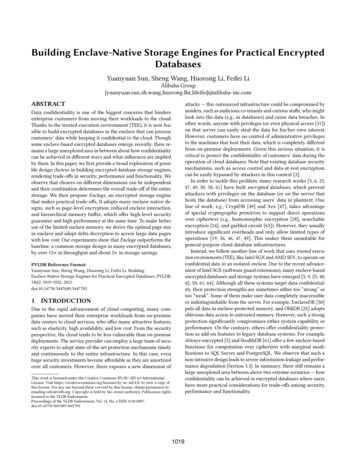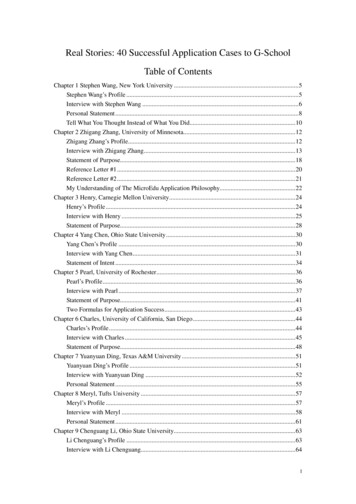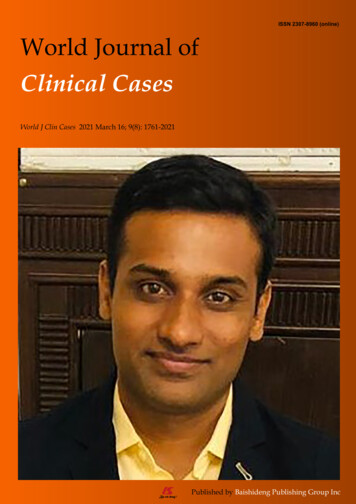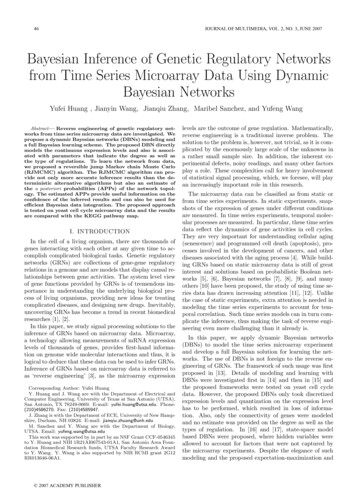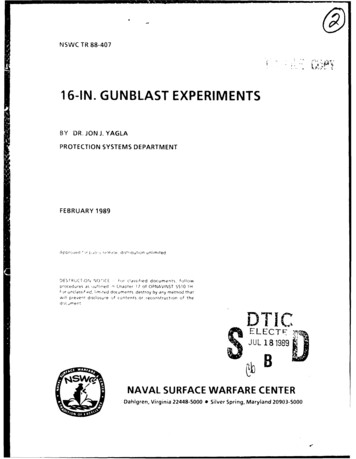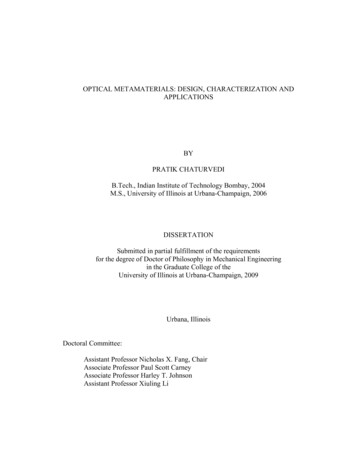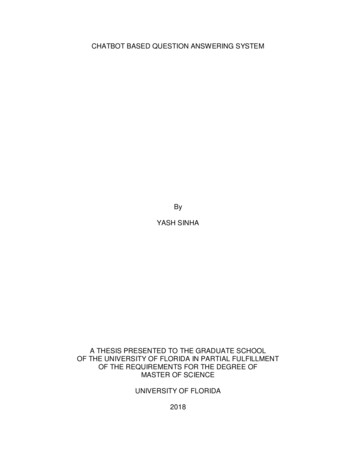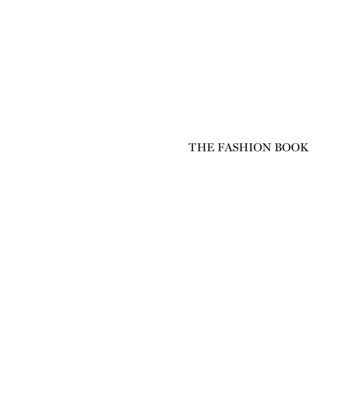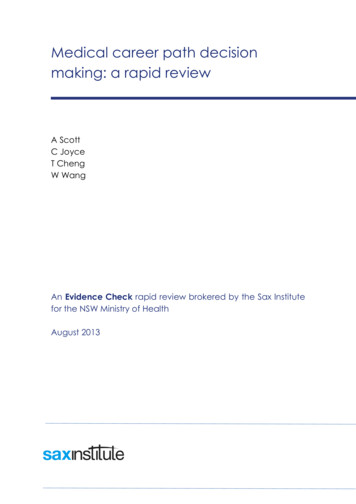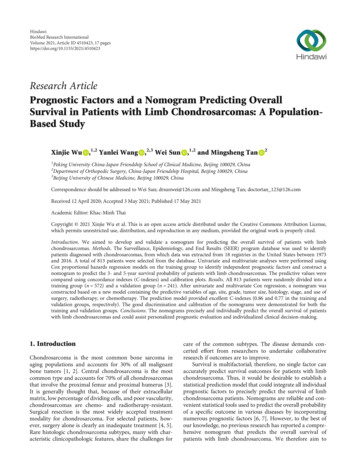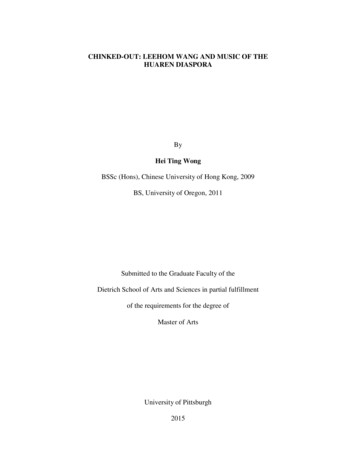
Transcription
CHINKED-OUT: LEEHOM WANG AND MUSIC OF THEHUAREN DIASPORAByHei Ting WongBSSc (Hons), Chinese University of Hong Kong, 2009BS, University of Oregon, 2011Submitted to the Graduate Faculty of theDietrich School of Arts and Sciences in partial fulfillmentof the requirements for the degree ofMaster of ArtsUniversity of Pittsburgh2015
UNIVERSITY OF PITTSBURGHDIETRICH SCHOOL OF ARTS AND SCIENCESThis thesis was presentedbyHei Ting WongIt was defended onApril 13, 2015and approved byThesis Director: Andrew N. Weintraub, Professor and Chair, Department of MusicJames P. Cassaro, Assistant Professor, Department of MusicGavin Steingo, Assistant Professor, Department of Musicii
Copyright by Hei Ting Wong2015iii
CHINKED-OUT: LEEHOM WANG AND MUSIC OF THE HUAREN DIASPORAHei Ting Wong, M.A.University of Pittsburgh, 2015This thesis examines the production and circulation of “Chinked-Out,” a form of musiccreated by Leehom Wang, a prominent American-born Taiwanese singer in the MandarinChinese popular music (Mandopop) industry. Chinked-Out’s fusion characteristics, as well asLeehom’s multicultural appeal, facilitate its circulation in the huaren (pan-Chinese/ethnicChinese) diaspora. Huaren refers to people of Chinese ethnicity, rather than the narrowdefinition of Chinese, which refers to people with Chinese nationality. In spite of the derogatorynature of the term “chink,” Leehom hopes to “repossess the word” and “make it cool” throughhis music (CNN, 2006). Although he has been experimenting with “Chinked-Out” since 2000,the term first appeared on his album Shangri-La in 2004. Derived from hip-hop with rap as themain component, Chinked-Out is not simply a form of hip-hop but also a fusion of other musicalelements such as jazz, rock, Kunqu opera, and Peking opera. Chinked-out blends Western andChinese instruments. As Leehom puts it, “Chinked-Out is a school of hip-hop” that “incorporatesChinese elements and sounds” (Ibid). This thesis contextualizes the success of Chinked-Out inraising global awareness about Chinese popular music by examining the history of Taiwan, itspopular music industry, the role of music in diaspora, and Leehom’s personal musical style andimage.Keywords: Leehom Wang, Chinked-Out, Taiwan, Mandopop, diasporaiv
TABLE OF CONTENTSPREFACE. VIIIACKNOWLEDGEMENT . X1.0INTRODUCTION. 12.0CHINKED-OUT SONGS AND THEIR MEANINGS. 283.0CHINKED-OUT AND DIASPORA . 47APPENDIX I . 68APPENDIX II . 69APPENDIX III . 71APPENDIX IV . 74REFERENCES CITED . 76v
LIST OF TABLESTable 1. Meanings and usages of the term “Chink”. 17Table 2. Mandarin Chinese discography of Leehom . 68Table 3. Leehom’s involvement in Mandarin Chinese songs production (1995-2003) . 70Table 4. The list of Chinked-Out songs . 73Table 5. Chinked-Out songs categorized by characteristics . 75vi
LIST OF FIGUREFigure 1. Leehom’s music dragon symbol . 40vii
PREFACEThis MA thesis is an extension of my previous project titled “Where the East MeetsWest: Leehom Wang and his ‘Chinked-Out’ Music,” a paper which I presented at the NorthwestChapter of the Society for Ethnomusicology meeting in 2012 at the University of Oregon. Mypaper was timely as the racially charged term “chink” had been in the news; a week before themeeting, a television newscaster used the phrase “chink in the armor” to describe Jeremy Lin, theAmerican-born Taiwanese NBA player. In my previous project, my main question was whetherChinked-Out could be considered an individual musical genre. To answer this question, Iinvestigated the musical characteristics of Chinked-Out. Since Leehom is the only personworking on this type of music, my conclusion was that Chinked-Out is a form of expressionunique to Leehom, rather than a distinct musical genre. 1In this thesis, I investigate Chinked-Out from another perspective: the circulation ofChinked-Out in the context of diaspora and huaren identity. Huaren refers to people of Chineseethnicity, rather than the narrow definition of Chinese, which refers to people with Chinesenationality. Leehom grew up in a predominantly white community in the United States andexperienced marginalization as an ethnic minority. Chinked-Out music relates to issues of racial1I believe it is Leehom’s goal to transform Chinked-Out into a genre. He does not want hismusic to be understood solely in the context of the “China wind/wave” (Zhongguofeng). Hisideas correspond to Fabian Holt’s (2007) ideas about genre: in order for a style of music tobecome a genre, it has to have a name, be recognized collectively both musically and socially,and be produced repeatedly by a group of people (pp.2-3).viii
and ethnic identity. Leehom’s multicultural identity and his desire to express his pride in beingTaiwanese and part of the huaren community have inspired his music. By focusing on thedevelopment, repertoire, circulation, and meanings of Chinked-Out, this thesis attempts toprovide a better understanding of Chinked-Out in the context of diaspora.ix
ACKNOWLEDGEMENTI would like to thank and acknowledge many people, who have made me a better person andprovided guidance on my personal growth and career path.Many thanks to –My best friends Vanassa Mau, Helen Law, Ted Hui, Ling Chuang, Tracy Li, Joey Cheung,Tommy Lam, Jackie Leung, Vivien Kwok, Teo Siew Kuang, Carol Tsang, Cannon Fung,Raymond Lau, Maggie Chik, Yabi Shek, Hatty Lui, Kaza Wong, and Dr. Paul Luk, for fightingthe graduate school battle with me throughout the years.Mr. Leehom Wang. Without him and his music, I would not be able to write this MA thesis.My thesis committee chair Prof. Andrew N. Weintraub for meeting with me, giving me advice,and walking me through the whole process.My thesis committee members Prof. Gavin Steingo and Prof. James Cassaro for offering meconstant support during the whole year of production.Special thanks to Prof. Lee Tong Soon at the Chinese University of Hong Kong (CUHK) andProf. Shalini Ayyagari at the American University for giving me advice and suggestions on thisproject at the initial stage.Prof. Deane Root, Prof. Rachel Mundy, Dr. Emily Pinkerton, and Dr. Robbie Beahrs, for yourencouragement and support in completing this thesis.Ms. Zhang Haihui and Mr. Mark Scott at the Hillman Library for assisting with this research.My teachers-cum-parents in my alma maters for your sustained love, care, and support: myadvisor Prof. Hal Sadofsky, Prof. Wang Hao, Prof. Loren Kajikawa, Dr. Barbara Baird, Dr. MarkLevy and Prof. Carol Silverman at the University of Oregon (UO); my advisor Prof. Ting KwokFai, Prof. Wong Yiu Kwan, and Dr. Au Yeung Wai Hoo at CUHK; my mentor Prof. Tao Lin atCUHK (now at Peking University); Ms. Wong Wai Shan and Ms. Szeto Shui Chun at SKHx
Tsang Shiu Tim Secondary School; and Ms. Tsang Siu Lin at PLK Vicwood K. T. Chong SixthForm College.My bosses and colleagues for your patience, friendship, and support: my mentor Prof. IanAitken, Prof. Camille Depréz, Prof. Lo Wai Luk, Angel Tsang, Edward Kwok, Joe Fu, andShirley Yeung at the Academy of Film of Hong Kong Baptist University; Ms. Kim Lilley, Ms.Kalindi Davi-Dasi, and Ms. Amy Nuetzman at the UO Teaching and Learning Center; Ms.Claudia Chan, Fion Ng, May Tsang, Tracy To, and John Wong at the CUHK Department ofSociology.The 2013-entry cohort for being my brothers and sisters in Pittsburgh; our family-like friendshipalways warms my heart: Li Lu-han, Juan Fernando Velasquez (and his wife Catalina Pineda),Kevin O’Brien, John Petrucelli, Danny Rosenmund, Jeff Klein, and Brian Riordan.My seniors here at Pitt for your care and support: Dr. Yoko Suzuki, Dr. Indra Ridwan (and hiswife Nita Yulia Anggraeni), Dr. Charles Lwanga, Dr. Matt Aelmore, Mr. Ren Meng, Ms. LiaoPei-ju, Ms. Parichat Duangkhae, Ms. Ellie Martin, and Mr. Alec MacIntyre. Special thanks to Dr.Sung Shih-hsiang and Ms. Tsai Hsin-yi for obtaining materials for me from Taiwan.Ms. Paula Riemer and Ms. Courtney Cameron of the Department of Music office foradministrative help.The members of the 2015-2016 Handbell Ensemble, Spring 2016 Gamelan Ensemble andAfrican Music and Dance Ensemble, for the accompaniment, as well as the tough and fun timeswe shared.My Oregon family and friends for your love and the bonding we have: Betsy Yates, JamieWaggoner, and Aleah Wilkie; my Eugene grandmas Mary Ann Plunkett and Anne Taylor;Megan Knowles and the Liudahls, especially my Salem mum Jamie and grandma Jane; and myhost parents in Eugene, Barbara and Peter Bergreen.My family in Hong Kong, especially my paternal family, for letting your only child and theeldest grandchild to pursue her dream abroad. My grandpa is always my inspiration and my mostsupportive friend since childhood.“Lo Tin Ye” (the God of the Sky) for leading my wonderful and adventurous life journey, andallowing me to meet the amazing people mentioned above who give me courage and love toachieve my goals.With love and respect,Hei TingPittsburgh, PA, USAMay 2015xi
1.0INTRODUCTIONIntroductionSince 2000, Leehom Wang 2 has been experimenting with his personal musical style,Chinked-Out. Because of its Chinese elements, including the pentatonic scale, Chinesetraditional/ethnic musical instruments, and lyrics inspired by traditional Chinese stories, themedia and audience often associate Chinked-Out with Chinese identity and pride. However,Leehom defines Chinked-Out as “a school of hip-hop” that reflects a mixture of musicalelements (CNN, 2006). By examining the characteristics of the entire Chinked-Out repertoire ofsongs, I argue that Chinked-Out is not simply a product of Leehom’s huaren identity, but it alsorelates to how he positions himself and Chinese popular music in the era of diaspora andglobalization. I examine the diasporic history of Taiwan and its multi-lingual popular musicindustry, underscoring Leehom’s significant contributions. I show how Chinked-Out relates tohis concept of “W-pop.” W-pop, which is discussed further in chapter 3, refers to “world2Chinese given names (first name) almost always consist of one or two characters, and arewritten after the surname (last name). Generally speaking, for Taiwanese, the two-character firstname is separated by a hyphen, as in Wang Lee-hom; for mainland Chinese, the first name istreated as one word in English, as in Wang Leehom; for people from Hong Kong, the twocharacter given name is separated by a space, as in Wang Lee Hom. In Leehom’s case, however,the way his name is written does not reflect his Taiwanese descent. As the Romanized system inTaiwan is different from the Mandarin Chinese pinyin system, unknown Romanized Taiwanesenames are generated through the translation generator on the website of the Bureau of ConsularAffairs of the Taiwan government at http://www.boca.gov.tw/sp.asp?xdURL E2C/c21025.asp&CtNode 677&mp 1.1
popular” music. The goal of Chinked-Out and W-Pop is to use music to break down boundariesbetween humans of different races and ethnicities.Theoretical frameworkAppropriation and reappropriation are two concepts utilized by Leehom in coining hismusic as Chinked-Out. Leehom appropriated musical elements of rap. Musical (or cultural)appropriation in this case refers to the adaptation and integration of musical elements, andsubsequent commercial success, by artists who occupy socio-economic and racial positions thatare different from the people and places of the music’s origin. This is especially problematic inthe case of hip-hop due to the racially segregated nature of the music industry in the UnitedStates, where authenticity is a key feature of the genre. In this thesis, I show how Leehomappropriated rap in order to express his personal artistic vision and his socio-political views.Rap was first used by young male African Americans in order to “acquire a powerfulpublic voice and presence via cultural production” (hooks, 2012, pp.315-316). bell hooks claims“Rap music provides a public voice for young black men who are usually silenced andoverlooked” to express the pain that “black people experience daily in a white supremacistcontext [which] is caused by dehumanizing oppressive forces” (p.315). The condition ofAmerican-born Taiwanese (and American-born Chinese in general), or huaren, in America is notthe same as African Americans in the United States, but both groups are considered to bemarginalized ethnic minorities. By using rap, Leehom signals the similarities between these twomarginalized groups.Leehom reappropriated the derogatory term “chink” in his music. As an American-bornTaiwanese, Leehom is a member of a stigmatized group which affords him the opportunity to2
reappropriate negative labels, such as Chink, which are often applied to his ethnic group.Galinsky et al. (2003) defines the meaning of reappropriation as it applies to identityconstruction among stigmatized groups:Given that to appropriate means “to take possession of or make use of exclusively foroneself,” we consider reappropriate to mean to take possession for oneself that which wasonce possessed by another, and we use it to refer to the phenomenon whereby astigmatized group revalues an externally imposed negative label by self-consciouslyreferring to itself in terms of that label (p.222).By calling some of his music Chinked-Out, Leehom reappropriates the derogatory term “Chink.”By using the term Chink to describe his musical style, he is not only “mak[ing] it cool” but he isreappropriating the term to produce a positive outcome.My thesis contributes to the study of music and diaspora. Simon Dubnow defineddiaspora in 1931 as “a Greek term for a nation or part of a nation separated from its own state orterritory and dispersed among other nations by preserving its national culture” (cited in Turino,2004, p.7). The term was explored in different disciplines, but it did not catch the attention ofmusic scholars until the early-1990s. Ethnomusicologist Mark Slobin was one of the pioneeringfigures in research on music and diaspora. As the guest editor of the journal Diaspora (1994),Slobin wrote an introduction for the issue on music travelling with people in diaspora to Europeand North America. In this article, he states “Music is central to the diasporic experience, linkinghomeland and here-land with an intricate network of sound” (p.243). Slobin compares music to“cultural baggage” – a physical cultural product (p.244). Music indexes one’s identity in thediaspora, and is the primary agent of identity, along with the voice, cultural meaning, andlanguage it carries (pp.243-244). He also states some of these minorities in the new destinationschoose to keep their own music “pure” in the new place, but some choose to combine the music3
from their original culture with the new culture; music is a flexible, hidden, or visible,identification marker among people in diaspora (p.245).However, the issue of music and diaspora is more complicated than the scholarship of the1990s indicates. First, diaspora must be disentangled from specific geographical locations. It is astudy of migration, about the mobility of humans, and the culture they carry and cultivate in theprocess. As a part of the culture, music no longer stays stationary, and may reflect a certain levelof hybridity with other cultures in contact during the diasporic process.Second, diaspora is not a one-way phenomenon; it is not only about people leaving theirplace of origin and settling in a new place. This understanding was explored in BenedictAnderson’s concept of imagined communities (1991). As Tina K. Ramnarine (2007) states,A classical concern in diaspora studies has been the relationship between diasporiccontext and a homeland elsewhere, with displacement, transnationalism and nationalismappearing as central analytical tropes (p.2).Ramnarine shifts the focus displacement to two modes of diasporic study: “history” and“newness”:The former mode [history] reminds us that diasporas are historically specific and that thepast shapes a sense of diasporic identity while the latter [newness] prompts us to questionthe rigidities and essentialisms of “diasporic identity.” (Ibid).In addition, Um Hae-kyung (2005) writes that the study of diaspora is not only about “‘lookingback’ to the past but also the making of new communities and transformation of traditions,neighbourhoods and cultures” (p.5).Third, the children of the diasporic parents often relocate to their “homeland” as part of areverse diaspora. This research direction is comparatively new but is gaining traction, withsignificant foreseeable growth, especially in immigrant societies. In addition, the way thatimmigrants deal with the culture in which they grew up, and the imagined “homeland” culture,4
are essential topics. This case study of Leehom’s music investigates the trend of having multipleroutes in the diaspora, as well as the idea of an imagined homeland.Summary of chaptersThe first chapter is an introduction. The discussion includes academic writings onLeehom. Most of these writings link Leehom’s music with Chineseness, Chinese identity, and agenre of Chinese popular music called Zhongguofeng, which means “China wind/wave.”However, I suggest that using the framework of Zhongguofeng or just focusing on Chineserelated issues limits the discussion on Chinked-Out. And most of these writings only focus on thefirst two Chinked-Out albums without addressing what Chinked-Out is, or the development ofChinked-Out. In order to understand Chinked-Out, it is necessary to understand the backgroundof Leehom, the history of Taiwan, and the development of the contemporary popular music inTaiwan. As he started his career in Taiwan, these issues shed light to the acceptance andpopularity of Leehom in Taiwan, and the meanings of his creation Chinked-Out.Chapter two includes my analysis of the musical elements of Chinked-Out. Leehomclaims that Chinked-Out is a school of hip-hop mixed with Chinese elements (CNN, 2006). Sixout of 11 tracks on the first Chinked-Out album Shangri-La have rap. However, based on myexamination of the album, I contend that songs without rap but with Chinese elements shouldalso be considered as Chinked-Out. For example, I consider the title song “Shangri-La” asChinked-Out because it includes an arrangement of Chinese ethnic minority musical instruments,is composed in a pentatonic scale, and includes a Tibetan theme. Therefore, I contend thatChinked-Out songs either have rap, Chinese musical elements, or Chinese traditionalstories/literature in them. I examined Leehom’s 18 Mandarin Chinese albums and located all the5
Chinked-Out songs. In conclusion, there are 36 Chinked-Out songs in total. The first ChinkedOut song is “Long De Chuan Ren 2000” (“Descendants of the Dragon 2000”; also referred to as“Descendants of the Dragon”). I have listed in Appendix III how these 36 songs match thecriteria of Chinked-Out, and I have divided these songs into seven different categories to showthe characteristics of Chinked-Out as shown in Appendix IV, which will be discussed in chapter2.The third and last chapter discusses the diasporic issues of Chinked-Out in the huarendiaspora based on an analysis of the lyrics of Chinked-Out. The lyrics of Chinked-Out areimportant for two reasons: 1. Rap is an important element of hip-hop, and Chinked-Out isclaimed as a school of hip-hop, and; 2. The lyrics explicitly state Leehom’s messages and ideas.Scholars state that the huaren diaspora is a special phenomenon as huaren tend to maintain aconnection with their homeland, especially with the mentality of “luo ye gui gan (falling leavesreturning to the roots).” This connection is facilitated by technological advancements that allowpeople to communicate with each other over long distances. Leehom, as a huaren, also sharesthis connection with Asia, and his identity is reflected in his music. He also considers himself anambassador of Chinese popular culture to advocate for huaren, and to link Chinese popularmusic to the global popular music industry. The multi-genre Chinked-Out and his multi-culturalimages, such as music gypsy and Music-Man, are Leehom’s tools to achieve his goal – to usemusic to break down racial, ethnic, and cultural boundaries between different groups of people.This study hopes to offer a more comprehensive exploration of Chinked-Out. With themulti-cultural and multi-ethnical issues embedded in the identity of Leehom, Chinked-Out is areflection of Leehom’s experience as a minority in the United States, his identity as a huaren,and his wish to eliminate boundaries between different people. I conclude with a discussion of an6
on-going process called “from C-pop to W-pop,” through which Leehom believes Chinesepopular music (C-pop) and other regional popular music will eventually merge into Worldpopular music (W-pop). In this case, Chinese popular music is not only Mandarin popular music(Mandopop), but it also includes popular music sung in other Chinese dialects. I believe it isLeehom’s wish to use Chinked-Out as a representative of Chinese popular music in order toconnect with the world and to speak for and advocate for huaren. However, it is an ongoingprocess that has not reached its end goal yet, as Chinese popular music has not been recognizedon the world stage and the new genre “W-pop” has not yet emerged. Therefore, this MA thesisanalyzes and documents the fusion phenomenon of Chinked-Out and the beginning of the W-popmovement. It is my hope that this study will contribute to the fields of ethnomusicology, AsianAmerican studies, and Asian studies.Leehom WangLeehom was born in 1976, the year of the dragon in the Chinese lunar calendar, inRochester, New York, to a Taiwanese immigrant family. According to an interview on thetelevision talk show Swallow Time, his parents met as graduate students in the United States(2002, October). In 1972, the couple relocated to Rochester, New York, where Leehom’s fathertook a job at the Genesee Hospital (University of Rochester Medical Center). Raised in Pittsford,a suburb of Rochester, English is Leehom’s mother tongue. He revealed in some interviews andspeeches that he suffered from racial discrimination, and was bullied in school, as Rochester wasa white-dominated community. According to the decennial census conducted by the CensusBureau of the United States Government in 1980 and 1990, more than 95 percent of Pittsford7
residents were white in the 1980s and 1990s, with only a small Asian population (SocialExplorer). 3 The population was also wealthy and educated (Ibid).Being an ethnic minority in Rochester, Leehom’s experience of being bullied led him torealize the power of music to break down ethnic and racial barriers. In a speech at OxfordUniversity, he recalled a bullying incident he had in elementary school:I was born in Rochester, New York, [and] I barely spoke a word of Chinese. I didn'tknow the difference between Taiwan or Thailand. [ ] I was as American as apple pie,until one day on the third-grade playground, the inevitable finally happened: I got teasedfor being Chinese. Now every kid gets teased or being made fun of in the playground, butthis was fundamentally different and I knew right then and there. [ ] [Brian] startedmaking fun of me, saying ‘Chinese, Japanese, dirty knees, look at these!’ [ ] I could stillremember how I felt, I felt ashamed, I felt embarrassed. But I laughed along with them,with everyone. And I didn't know what else to do. It was like having an out-of-bodyexperience, as if I could laugh at that Chinese kid on the playground with all the otherAmericans because I was one of them, right? Wrong, on many levels. And I was facingfor the first but definitely not the last time the harsh reality that I was a minority inRochester, which in those days had an Asian population of one percent. And I wasconfused. I wanted to punch Brian. I wanted to hurt him for putting me in that situation[ ] so I just took it in. I didn't tell anyone or share with anyone these feelings, I just heldthem in and I let them fester (Oxford Union, 2013, April 21).As I will explain in chapter 3, this incident had a profound impact on Leehom. It seems that theidea of Chinked-Out as a way to express his feelings about being bullied and put in the situationof a racialized minority in the United States has been in his mind since the third grade.It was also in Rochester where Leehom received classical music training. He beganstudying the violin when he was six (Wang & Jiaozi, 2003, p.12). During his high school years,he received formal musical training at the Eastman School of Music Community Extensionprogram (pp.32, 34, 38-39). He was one of three students to graduate with honors and was giventhe opportunity to have his recital at Kilbourn Hall (pp.38-39). At the same time, Leehom3Data obtained from Social Explorer are located by census tract. The data for 1980 is obtainedfrom tract numbers 112.1, 112.2, 123.1, and 123.2, and the data for 1990 is from numbers122.01, 122.02, 123.01, and 123.02. Searching by zipcode is unavailable.8
demonstrated his singing and acting talents by participating in his school’s annual musical. Hewas the lead actor of the school musical Kiss me, Kate, and the performance was reported inlocal newspapers and received accolades from professional actors in the city (pp.35-37).Leehom started his singing career unexpectedly. During the summer before his senioryear of high school, he travelled to Taipei, Taiwan, with his mother to visit his grandmother(Ibid, p.57). He participated in the “Mu Chuan (Wooden Boat)” Folk Song Singing Contest,which was an important singing competition for music producers and agents to scout for newsingers. 4 Leehom caught the attention of several music producers; in fact, he became such a greatattraction in the Taiwanese media that his mother forced him to quit the competition (pp.60-61).However, he signed a contract with BMG Taiwan that summer before heading back to the UnitedStates (p.61).Leehom attended Williams College (Williams) in Williamstown, Massachusetts, wherehe joined the male a cappella group “The Springstreeters,” and earned a bachelor’s degree inMusic and Asian Studies in 1998 (Ibid, pp.41-47). To fulfill the graduation requirement, he tookup the challenge to produce a Broadway-style musical, The Bite that Burns (pp.44-45). In 1999,he received a master’s degree in Music Performance from the Berklee College of Music(Berklee) in Boston, Massachusetts (Small, 2009). Leehom studied with jazz pianist Andy Jaffeat Williams, and Grammy award-winning singer Cheryl Bentyne and experienced musicengineer Rich Mendelson at Berklee (Ibid).4There are no resources found about this competition except from ex.php?title 4%B1%E5%A4%A7%E8%B3%BD&oldid 32323925). Some Taiwanese Mandopop singers, songwriters, or producers, were winners or participants inthis singing contest: Tom Chang Yu-sheng, Chang Chen-yue, Terry Lin Chih-hsuan, and CheerChen Chi-chen, among others.9
Leehom released his first album Love Rival Beethoven in Taiwan in 1995, but the albumsales were disappointing. He only became successful when his fifth album Revolution (1998)sold more than 100,000 copies. The album was released after he graduated from Williams, butbefore he matriculated at Berklee. In the 1999 Golden Melody Awards ceremony, Leehom wasrecognized with the Best Album Producer and the Best Mandarin Male Singer honors (GoldenMelody Awards). Hosted by the Taiwan Government Information Office and judged byrespectable industry insiders, the Golden Melody Awards are considered the Grammy Awards ofTaiwan, and Leehom was the first person to win two major awards in its history (SS Hsiao-yenNight, 2010, August 18). In the thirteen years he was affiliated with Sony Music Taiwan,Leehom released 16 Mandarin-language albums, with sales totaling five billion New TaiwanDollars (about 169 million USD) (United Daily News, 2011, September 7, C3).Academic writings on Leehom Wang and Chinked-OutAcademic writings on Leehom encompass musicological topics (pentatonic scale,composition, and hybridity) as well as the meanings of his songs, his identity, and his influenceon the music industry. This section discusses scholarly research related to popular music inTaiwan, Leehom, and Chinked-Out.Chiang Tin-yi’s (2009) master’s thesis studies the phenomenon of Zhongguofeng (theChina wind/wave), a genre of Chinese popular music. Referring to Taiwanese ly
created by Leehom Wang, a prominent American-born Taiwanese singer in the Mandarin Chinese popular music (Mandopop) industry. Chinked-Out’s fusion characteristics, as well as Leehom’s multicultural appeal, facilitate its circulation in the . huaren (pan-Ch
